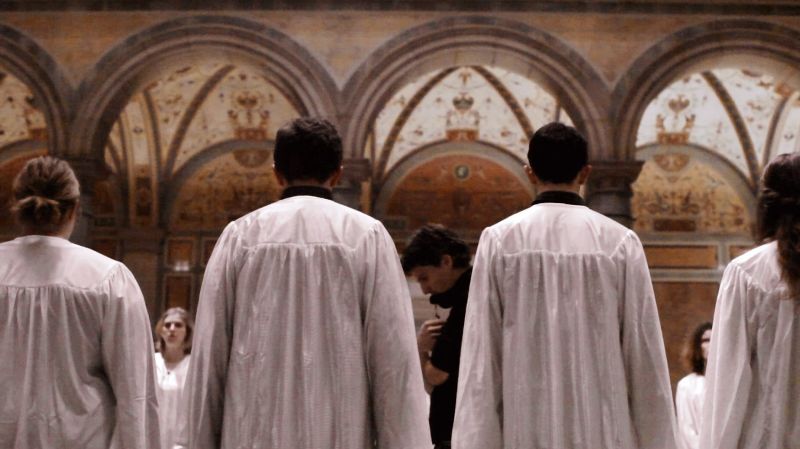Ohne das Wissen um die Komplexität visueller Kultur zu vergessen, wenden sich aktuell bildende Künstlerinnen und Künstler wieder dem Hörerlebnis zu und erkunden dieses neu. Welche Techniken finden in diesen Produktionen akustischen Denkens ihre Anwendung, was kann entstehen, wenn Text- und Tonträger eigenständig

Sound & Buch Akustisches Denken in der Kunst
Gast im Salon: Seth Weiner
Choir Corridor
Ohne das Wissen um die Komplexität visueller Kultur zu vergessen, wenden sich aktuell bildende Künstlerinnen und Künstler wieder dem Hörerlebnis zu und erkunden dieses neu. Welche Techniken finden in diesen Produktionen akustischen Denkens ihre Anwendung, was kann entstehen, wenn Text- und Tonträger eigenständig miteinander in Beziehung treten?
Im Rahmen einer Ausstellung zum Thema Sound & Buch lädt Bernhard Cella zu einer Reihe von Veranstaltungen, die gegenwärtige Positionen akustischen Denkens und ihre Beziehung zum Medium Buch verhandeln.
Mit seinem Projekt Choir Corridor entwickelte der amerikanische Künstler Seth Weiner einen Score für eine orts- und raumspezifische Performance 2013 in der MAK-Säulenhalle. Aufgeführt von 60 Mitgliedern des Wiener Kammerchors und des Boku-Chors untersuchte das Projekt das Zusammenspiel von menschlicher Interaktion und Raum in Hinblick auf Gruppendynamiken, Mechanismen der Crowd-Control und Stimmen. Für die Veranstaltung entstand das Künstlerbuch Roaming Architectural Objects in limitierter Auflage.
Sound & Book
Acoustic Thought in the Fine Arts
Without neglecting their knowledge of the complexity of visual culture, fine artists have returned to exploring the listening experience. Which techniques are employed in these productions of acoustic thought, what can emerge when carriers of text and sound autonomously enter into a relationship? Within the framework of an exhibition on the topic of sound and books, Bernhard Cella invites you to a series of events which negotiate contemporary positions of acoustic thought and their relation to the medium of the book.
For his project Choir Corridor, artist Seth Weiner developed a score for a site- and space-specific performance at the MAK’s Columned Main Hall in 2013. Performed by sixty members of the Vienna Chamber Choir and Boku Choir, the project examined the interplay of human interaction and space with regard to group dynamics, mechanisms of crowd control and voice.
A limited-edition artist’s book Roaming Architectural Objects was also produced specifically for the event.
“[…] When I first arrived in L.A. a few years ago, I moved into a house that was nested within a tight residential grid on the northeast border of Atwater Village, directly above Chevy Chase Blvd. Surrounded by large plots of indiscriminate box stores and scrap yards, the neighborhood was the result of colliding axis, its shape gently influenced by the contour of the adjacent and often dry L.A. River. At its edges the neighborhood stopped abruptly, the shift in scale obstructed by thin strips of bushes which were absorbed by a long chain link fence. On the western block of Sequoia, the road’s straightness held a series of squat apartment buildings and duplicate shotgun homes with small front lawns, sunburnt facades and tall, rusted white metal gates. Predictable and relentless, the sequence of gates mirrored the social space of each preceding street, their careful rectangle boundaries pushing lawn and landscape to the limits of each property line. Without much notice the street terminated in a lot covered with bleached brush. From that dead end, spots of colored planes and corrugated aluminum from a scrap yard peeked through the growth, disconnected and easily ignored. At night when it was quiet, you could hear intermittent tides of traffic from the I-5 filling the riverbed with melodic noise, their movement resonating along the sloped concrete embankments, teasing the absence of water with its own sound.”
From “Mythical Boundaries” in Roaming Architectural Objects, 2013
Seth Weiner (1982, USA) studied architecture at SCI-Arc in Los Angeles and drawing and painting at the University of Michigan, Ann Arbor. Often containing performance and proposal simultaneously, his work employs a wide range of media in which he explores the gaps between architectural fiction and social convention to create both actual and imagined spatial environments. Whether working with performance, research, exhibition structures or education, his practice approaches questions surrounding the acquisition and performance of knowledge, the role of space and form as social actors, and the development of strategies for interrogating and redefining constructed contexts and privileged patterns of behavior.
Bernhard Cella is interested in the economic and sculptural framework in which artists’ books – highly informed objects in themselves – can be used as artistic materials. To this end, he conceptualized the ’Salon für Kunstbuch’, a life-size model of a bookshop, in his studio in Vienna. Since 2007, more than 10.000 artists' books have accumulated and entered into unfamiliar vicinities and dialogues. Buying and selling these objects become an integral part of an original artistic practice.
www.cella.at http://collectingbooks.cella.at www.salon-fuer-kunstbuch.at
Seth Weiner: Choir Corridor, 2013. “Unable to immediately turn in any direction the entrance stretches through the corridor, prolonged by a view of itself from above. Unplugged faces, rehearsing one another’s limits, voices approaching the sensation of stability. An almost-object, the group unravels into its figures, the architectural consequences of all of those bodies pressed together in space.”
Back Choir Corridor Score, Seth Weiner, 2013
Book Choir Corridor, Open Score, Seth Weiner, 2013
Praise Model (Deep Blue)




